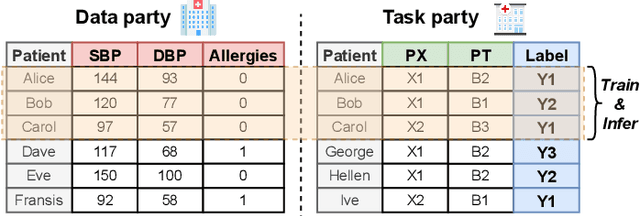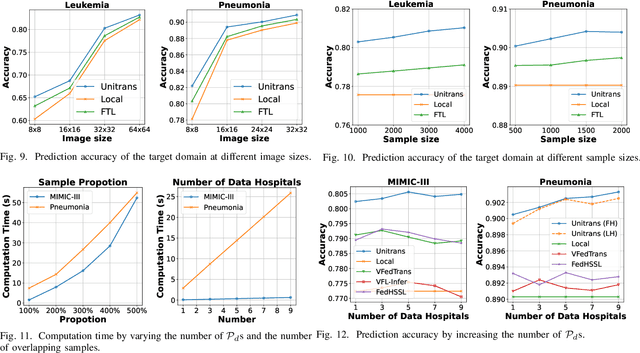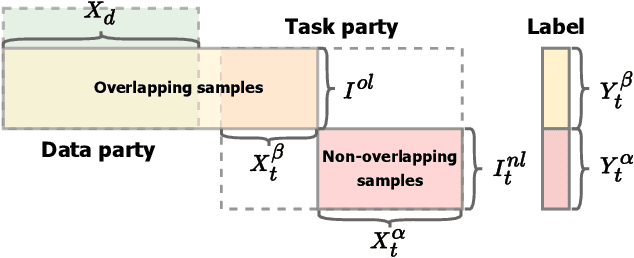Leye Wang
VeFIA: An Efficient Inference Auditing Framework for Vertical Federated Collaborative Software
Jul 03, 2025



Abstract:Vertical Federated Learning (VFL) is a distributed AI software deployment mechanism for cross-silo collaboration without accessing participants' data. However, existing VFL work lacks a mechanism to audit the execution correctness of the inference software of the data party. To address this problem, we design a Vertical Federated Inference Auditing (VeFIA) framework. VeFIA helps the task party to audit whether the data party's inference software is executed as expected during large-scale inference without leaking the data privacy of the data party or introducing additional latency to the inference system. The core of VeFIA is that the task party can use the inference results from a framework with Trusted Execution Environments (TEE) and the coordinator to validate the correctness of the data party's computation results. VeFIA guarantees that, as long as the abnormal inference exceeds 5.4%, the task party can detect execution anomalies in the inference software with a probability of 99.99%, without incurring any additional online inference latency. VeFIA's random sampling validation achieves 100% positive predictive value, negative predictive value, and true positive rate in detecting abnormal inference. To the best of our knowledge, this is the first paper to discuss the correctness of inference software execution in VFL.
Auditing Data Provenance in Real-world Text-to-Image Diffusion Models for Privacy and Copyright Protection
Jun 13, 2025Abstract:Text-to-image diffusion model since its propose has significantly influenced the content creation due to its impressive generation capability. However, this capability depends on large-scale text-image datasets gathered from web platforms like social media, posing substantial challenges in copyright compliance and personal privacy leakage. Though there are some efforts devoted to explore approaches for auditing data provenance in text-to-image diffusion models, existing work has unrealistic assumptions that can obtain model internal knowledge, e.g., intermediate results, or the evaluation is not reliable. To fill this gap, we propose a completely black-box auditing framework called Feature Semantic Consistency-based Auditing (FSCA). It utilizes two types of semantic connections within the text-to-image diffusion model for auditing, eliminating the need for access to internal knowledge. To demonstrate the effectiveness of our FSCA framework, we perform extensive experiments on LAION-mi dataset and COCO dataset, and compare with eight state-of-the-art baseline approaches. The results show that FSCA surpasses previous baseline approaches across various metrics and different data distributions, showcasing the superiority of our FSCA. Moreover, we introduce a recall balance strategy and a threshold adjustment strategy, which collectively allows FSCA to reach up a user-level accuracy of 90% in a real-world auditing scenario with only 10 samples/user, highlighting its strong auditing potential in real-world applications. Our code is made available at https://github.com/JiePKU/FSCA.
ChatPD: An LLM-driven Paper-Dataset Networking System
May 28, 2025Abstract:Scientific research heavily depends on suitable datasets for method validation, but existing academic platforms with dataset management like PapersWithCode suffer from inefficiencies in their manual workflow. To overcome this bottleneck, we present a system, called ChatPD, that utilizes Large Language Models (LLMs) to automate dataset information extraction from academic papers and construct a structured paper-dataset network. Our system consists of three key modules: \textit{paper collection}, \textit{dataset information extraction}, and \textit{dataset entity resolution} to construct paper-dataset networks. Specifically, we propose a \textit{Graph Completion and Inference} strategy to map dataset descriptions to their corresponding entities. Through extensive experiments, we demonstrate that ChatPD not only outperforms the existing platform PapersWithCode in dataset usage extraction but also achieves about 90\% precision and recall in entity resolution tasks. Moreover, we have deployed ChatPD to continuously extract which datasets are used in papers, and provide a dataset discovery service, such as task-specific dataset queries and similar dataset recommendations. We open source ChatPD and the current paper-dataset network on this [GitHub repository]{https://github.com/ChatPD-web/ChatPD}.
ACU: Analytic Continual Unlearning for Efficient and Exact Forgetting with Privacy Preservation
May 18, 2025Abstract:The development of artificial intelligence demands that models incrementally update knowledge by Continual Learning (CL) to adapt to open-world environments. To meet privacy and security requirements, Continual Unlearning (CU) emerges as an important problem, aiming to sequentially forget particular knowledge acquired during the CL phase. However, existing unlearning methods primarily focus on single-shot joint forgetting and face significant limitations when applied to CU. First, most existing methods require access to the retained dataset for re-training or fine-tuning, violating the inherent constraint in CL that historical data cannot be revisited. Second, these methods often suffer from a poor trade-off between system efficiency and model fidelity, making them vulnerable to being overwhelmed or degraded by adversaries through deliberately frequent requests. In this paper, we identify that the limitations of existing unlearning methods stem fundamentally from their reliance on gradient-based updates. To bridge the research gap at its root, we propose a novel gradient-free method for CU, named Analytic Continual Unlearning (ACU), for efficient and exact forgetting with historical data privacy preservation. In response to each unlearning request, our ACU recursively derives an analytical (i.e., closed-form) solution in an interpretable manner using the least squares method. Theoretical and experimental evaluations validate the superiority of our ACU on unlearning effectiveness, model fidelity, and system efficiency.
AFCL: Analytic Federated Continual Learning for Spatio-Temporal Invariance of Non-IID Data
May 18, 2025Abstract:Federated Continual Learning (FCL) enables distributed clients to collaboratively train a global model from online task streams in dynamic real-world scenarios. However, existing FCL methods face challenges of both spatial data heterogeneity among distributed clients and temporal data heterogeneity across online tasks. Such data heterogeneity significantly degrades the model performance with severe spatial-temporal catastrophic forgetting of local and past knowledge. In this paper, we identify that the root cause of this issue lies in the inherent vulnerability and sensitivity of gradients to non-IID data. To fundamentally address this issue, we propose a gradient-free method, named Analytic Federated Continual Learning (AFCL), by deriving analytical (i.e., closed-form) solutions from frozen extracted features. In local training, our AFCL enables single-epoch learning with only a lightweight forward-propagation process for each client. In global aggregation, the server can recursively and efficiently update the global model with single-round aggregation. Theoretical analyses validate that our AFCL achieves spatio-temporal invariance of non-IID data. This ideal property implies that, regardless of how heterogeneous the data are distributed across local clients and online tasks, the aggregated model of our AFCL remains invariant and identical to that of centralized joint learning. Extensive experiments show the consistent superiority of our AFCL over state-of-the-art baselines across various benchmark datasets and settings.
A Unified and Scalable Membership Inference Method for Visual Self-supervised Encoder via Part-aware Capability
May 15, 2025Abstract:Self-supervised learning shows promise in harnessing extensive unlabeled data, but it also confronts significant privacy concerns, especially in vision. In this paper, we perform membership inference on visual self-supervised models in a more realistic setting: self-supervised training method and details are unknown for an adversary when attacking as he usually faces a black-box system in practice. In this setting, considering that self-supervised model could be trained by completely different self-supervised paradigms, e.g., masked image modeling and contrastive learning, with complex training details, we propose a unified membership inference method called PartCrop. It is motivated by the shared part-aware capability among models and stronger part response on the training data. Specifically, PartCrop crops parts of objects in an image to query responses within the image in representation space. We conduct extensive attacks on self-supervised models with different training protocols and structures using three widely used image datasets. The results verify the effectiveness and generalization of PartCrop. Moreover, to defend against PartCrop, we evaluate two common approaches, i.e., early stop and differential privacy, and propose a tailored method called shrinking crop scale range. The defense experiments indicate that all of them are effective. Finally, besides prototype testing on toy visual encoders and small-scale image datasets, we quantitatively study the impacts of scaling from both data and model aspects in a realistic scenario and propose a scalable PartCrop-v2 by introducing two structural improvements to PartCrop. Our code is at https://github.com/JiePKU/PartCrop.
Forgetting Any Data at Any Time: A Theoretically Certified Unlearning Framework for Vertical Federated Learning
Feb 24, 2025



Abstract:Privacy concerns in machine learning are heightened by regulations such as the GDPR, which enforces the "right to be forgotten" (RTBF), driving the emergence of machine unlearning as a critical research field. Vertical Federated Learning (VFL) enables collaborative model training by aggregating a sample's features across distributed parties while preserving data privacy at each source. This paradigm has seen widespread adoption in healthcare, finance, and other privacy-sensitive domains. However, existing VFL systems lack robust mechanisms to comply with RTBF requirements, as unlearning methodologies for VFL remain underexplored. In this work, we introduce the first VFL framework with theoretically guaranteed unlearning capabilities, enabling the removal of any data at any time. Unlike prior approaches -- which impose restrictive assumptions on model architectures or data types for removal -- our solution is model- and data-agnostic, offering universal compatibility. Moreover, our framework supports asynchronous unlearning, eliminating the need for all parties to be simultaneously online during the forgetting process. These advancements address critical gaps in current VFL systems, ensuring compliance with RTBF while maintaining operational flexibility.We make all our implementations publicly available at https://github.com/wangln19/vertical-federated-unlearning.
UniTrans: A Unified Vertical Federated Knowledge Transfer Framework for Enhancing Cross-Hospital Collaboration
Jan 20, 2025



Abstract:Cross-hospital collaboration has the potential to address disparities in medical resources across different regions. However, strict privacy regulations prohibit the direct sharing of sensitive patient information between hospitals. Vertical federated learning (VFL) offers a novel privacy-preserving machine learning paradigm that maximizes data utility across multiple hospitals. Traditional VFL methods, however, primarily benefit patients with overlapping data, leaving vulnerable non-overlapping patients without guaranteed improvements in medical prediction services. While some knowledge transfer techniques can enhance the prediction performance for non-overlapping patients, they fall short in addressing scenarios where overlapping and non-overlapping patients belong to different domains, resulting in challenges such as feature heterogeneity and label heterogeneity. To address these issues, we propose a novel unified vertical federated knowledge transfer framework (Unitrans). Our framework consists of three key steps. First, we extract the federated representation of overlapping patients by employing an effective vertical federated representation learning method to model multi-party joint features online. Next, each hospital learns a local knowledge transfer module offline, enabling the transfer of knowledge from the federated representation of overlapping patients to the enriched representation of local non-overlapping patients in a domain-adaptive manner. Finally, hospitals utilize these enriched local representations to enhance performance across various downstream medical prediction tasks. Experiments on real-world medical datasets validate the framework's dual effectiveness in both intra-domain and cross-domain knowledge transfer. The code of \method is available at \url{https://github.com/Chung-ju/Unitrans}.
Data and System Perspectives of Sustainable Artificial Intelligence
Jan 13, 2025Abstract:Sustainable AI is a subfield of AI for concerning developing and using AI systems in ways of aiming to reduce environmental impact and achieve sustainability. Sustainable AI is increasingly important given that training of and inference with AI models such as large langrage models are consuming a large amount of computing power. In this article, we discuss current issues, opportunities and example solutions for addressing these issues, and future challenges to tackle, from the data and system perspectives, related to data acquisition, data processing, and AI model training and inference.
STContext: A Multifaceted Dataset for Developing Context-aware Spatio-temporal Crowd Mobility Prediction Models
Jan 07, 2025Abstract:In smart cities, context-aware spatio-temporal crowd flow prediction (STCFP) models leverage contextual features (e.g., weather) to identify unusual crowd mobility patterns and enhance prediction accuracy. However, the best practice for incorporating contextual features remains unclear due to inconsistent usage of contextual features in different papers. Developing a multifaceted dataset with rich types of contextual features and STCFP scenarios is crucial for establishing a principled context modeling paradigm. Existing open crowd flow datasets lack an adequate range of contextual features, which poses an urgent requirement to build a multifaceted dataset to fill these research gaps. To this end, we create STContext, a multifaceted dataset for developing context-aware STCFP models. Specifically, STContext provides nine spatio-temporal datasets across five STCFP scenarios and includes ten contextual features, including weather, air quality index, holidays, points of interest, road networks, etc. Besides, we propose a unified workflow for incorporating contextual features into deep STCFP methods, with steps including feature transformation, dependency modeling, representation fusion, and training strategies. Through extensive experiments, we have obtained several useful guidelines for effective context modeling and insights for future research. The STContext is open-sourced at https://github.com/Liyue-Chen/STContext.
 Add to Chrome
Add to Chrome Add to Firefox
Add to Firefox Add to Edge
Add to Edge